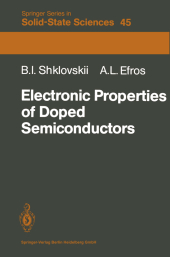 Neuerscheinungen 2012Stand: 2020-01-07 |
Schnellsuche
ISBN/Stichwort/Autor
|
Herderstraße 10
10625 Berlin
Tel.: 030 315 714 16
Fax 030 315 714 14
info@buchspektrum.de |

A. L. Efros, S. Luryi, B. I. Shklovskii
(Beteiligte)
Electronic Properties of Doped Semiconductors
Übersetzung: Luryi, S.
Softcover reprint of the original 1st ed. 1984. 2012. xii, 388 S. XII, 388 p. 235 mm
Verlag/Jahr: SPRINGER, BERLIN 2012
ISBN: 3-662-02405-5 (3662024055)
Neue ISBN: 978-3-662-02405-8 (9783662024058)
Preis und Lieferzeit: Bitte klicken
First-generation semiconductors could not be properly termed "doped- they were simply very impure. Uncontrolled impurities hindered the discovery of physical laws, baffling researchers and evoking pessimism and derision in advocates of the burgeoning "pure" physical disciplines. The eventual banish ment of the "dirt" heralded a new era in semiconductor physics, an era that had "purity" as its motto. It was this era that yielded the successes of the 1950s and brought about a new technology of "semiconductor electronics". Experiments with pure crystals provided a powerful stimulus to the develop ment of semiconductor theory. New methods and theories were developed and tested: the effective-mass method for complex bands, the theory of impurity states, and the theory of kinetic phenomena. These developments constitute what is now known as semiconductor phys ics. In the last fifteen years, however, there has been a noticeable shift towards impure semiconductors - a shift which came about because it is precisely the impurities that are essential to a number of major semiconductor devices. Technology needs impure semiconductors, which unlike the first-generation items, are termed "doped" rather than "impure" to indicate that the impurity levels can now be controlled to a certain extent.
I Lightly Doped Semiconductors.- 1. The Structure of Isolated Impurity States.- 2. Localization of Electronic States.- 3. The Structure of the Impurity Band for Lightly Doped Semiconductors.- 4. A General Description of Hopping Conduction in Lightly Doped Semiconductors.- 5. Percolation Theory.- 6. Dependence of Hopping Conduction on the Impurity Concentration and Strain in the Crystal.- 7. Hopping Conduction in a Magnetic Field.- 8. Activation Energy for Hopping Conduction.- 9. Variable-Range Hopping Conduction.- 10. Correlation Effects on the Density of States and Hopping Conduction.- II Heavily Doped Semiconductors.- 11. Electronic States in Heavily Doped Semiconductors.- 12. The Density-of-States Tail and Interband Light Absorption.- 13. The Theory of Heavily Doped and Highly Compensated Semiconductors (HDCS).- III Computer Modelling.- 14. Modelling the Impurity Band of a Lightly Doped Semiconductor and Calculating the Electrical Conductivity.- References.


